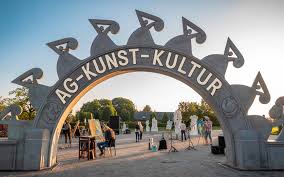Art and culture are powerful tools of expression, identity, and change. ag-kunst-kultur represents more than a name—it is a dynamic concept and community effort that explores the intersection of artistic creation, cultural practice, and societal dialogue. Whether you’re an artist, curator, educator, or cultural enthusiast, understanding the significance of ag-kunst-kultur can offer fresh perspectives on how art shapes our world today.
What is ag-kunst-kultur?
At its core, ag-kunst-kultur (short for Arbeitsgemeinschaft Kunst und Kultur) is a collaborative initiative or working group focused on promoting and supporting artistic and cultural projects. Originating primarily within German-speaking regions, it often refers to grassroots organizations, school clubs, or institutional networks that encourage artistic engagement and cultural education. These groups aim to foster creative thinking, community involvement, and cross-disciplinary dialogue.
The Purpose Behind ag-kunst-kultur
The goal of ag-kunst-kultur initiatives is to democratize access to the arts. By organizing workshops, exhibitions, performances, and public events, these groups bridge the gap between artists and the public. They often work within educational settings, cultural centers, or urban communities to bring people together through shared creative experiences. Whether it’s a painting seminar, a street art project, or a poetry slam, the objective is always the same—cultivate culture and inspire conversation.
Why ag-kunst-kultur Matters Today
In an increasingly digital and fragmented world, initiatives like ag-kunst-kultur play a vital role in preserving and evolving cultural identity. They give artists and thinkers space to reflect on pressing social issues such as climate change, migration, identity, and digitalization. Art becomes a mirror for society, and ag-kunst-kultur offers a stage for that reflection.
For example, many ag-kunst-kultur projects have been at the forefront of community activism. In Berlin, grassroots art collectives have painted murals addressing gentrification and displacement. In Vienna, cultural workshops have helped refugees express their stories through film and sculpture. These are more than artistic endeavors—they are acts of cultural dialogue and empowerment.
Key Activities and Examples of ag-kunst-kultur in Action
Here are some common formats and real-world applications of ag-kunst-kultur:
- Community Murals and Public Art Installations: Bringing art into public spaces to make it accessible and participatory.
- Intercultural Workshops: Teaching people of diverse backgrounds how to use visual or performance art to share their heritage and personal stories.
- Collaborative Exhibitions: Curating shows that bring together local and international voices under a shared theme.
- School-Based Art Groups: Encouraging students to explore creative disciplines outside the classroom.
- Art Therapy Sessions: Using painting, music, or dance to support mental health and emotional expression.
One standout example is Kulturwerkstatt Graz, an Austrian initiative that uses the principles of ag-kunst-kultur to host exhibitions, community discussions, and art therapy for youth. Their collaborative model has been adopted in other parts of Europe for cultural education and social development.
The Role of Digital Media in ag-kunst-kultur
As with many cultural movements, digital tools have transformed how ag-kunst-kultur operates. Social media platforms now act as virtual galleries. Digital art forms like AR installations, NFT exhibitions, and virtual reality performances are becoming integral to modern cultural expression. Many ag-kunst-kultur groups have embraced this shift, using online tools to expand reach and connect global audiences.
For instance, digital exhibitions organized during the COVID-19 pandemic allowed these groups to maintain engagement despite physical restrictions. Hybrid formats—where in-person workshops are live-streamed—have made art education more inclusive than ever.
Challenges Faced by ag-kunst-kultur Initiatives
While the intentions are noble, ag-kunst-kultur projects often face structural challenges:
- Funding Constraints: Many depend on government grants or donations, which can be inconsistent.
- Institutional Resistance: Traditional art institutions may be slow to embrace grassroots approaches.
- Audience Reach: It’s not always easy to engage wider communities, especially those unfamiliar with contemporary art.
- Digital Divide: Though digital tools offer opportunities, access to tech and internet infrastructure is not universal.
These hurdles require creative solutions. Collaborative funding models, cross-sector partnerships, and more inclusive programming can help sustain the impact of ag-kunst-kultur efforts.
How You Can Support or Join ag-kunst-kultur Projects
Whether you’re a professional artist or someone with a passion for culture, there are many ways to engage with ag-kunst-kultur:
- Volunteer for local art initiatives and support community-driven exhibitions.
- Join cultural forums or discussion groups focused on interdisciplinary art and social themes.
- Participate in online workshops hosted by ag-kunst-kultur organizations.
- Contribute your skills—whether in marketing, curation, writing, or teaching.
- Donate to grassroots cultural funds that support creative and social engagement.
Supporting these initiatives means advocating for a world where creativity is a shared language.
Conclusion:
ag-kunst-kultur is more than a term—it’s a vibrant, evolving ecosystem of art, community, and culture. These collaborative groups and projects challenge the traditional boundaries of art by making creativity accessible, inclusive, and socially relevant. From street art to digital installations, from schools to public parks, ag-kunst-kultur reminds us that art is not just a product but a process—one that shapes how we see ourselves and the world.
If you care about culture and community, now is the time to get involved—start local, think global, and let creativity lead the way.
FAQs – Frequently Asked Questions
What does ag-kunst-kultur mean?
It stands for “Arbeitsgemeinschaft Kunst und Kultur” and refers to collaborative groups promoting art and cultural initiatives in community or educational settings.
Where can I find ag-kunst-kultur projects?
They are often found in schools, cultural centers, urban art collectives, and online platforms in Germany, Austria, and Switzerland.
Who can participate in ag-kunst-kultur?
Anyone interested in creative collaboration—artists, educators, students, or volunteers—can take part.
How is ag-kunst-kultur funded?
Most projects rely on public grants, arts foundations, private donations, and sometimes crowdfunding.
Is ag-kunst-kultur only about visual art?
No, it includes various forms of artistic expression such as theater, dance, literature, digital art, and more.

